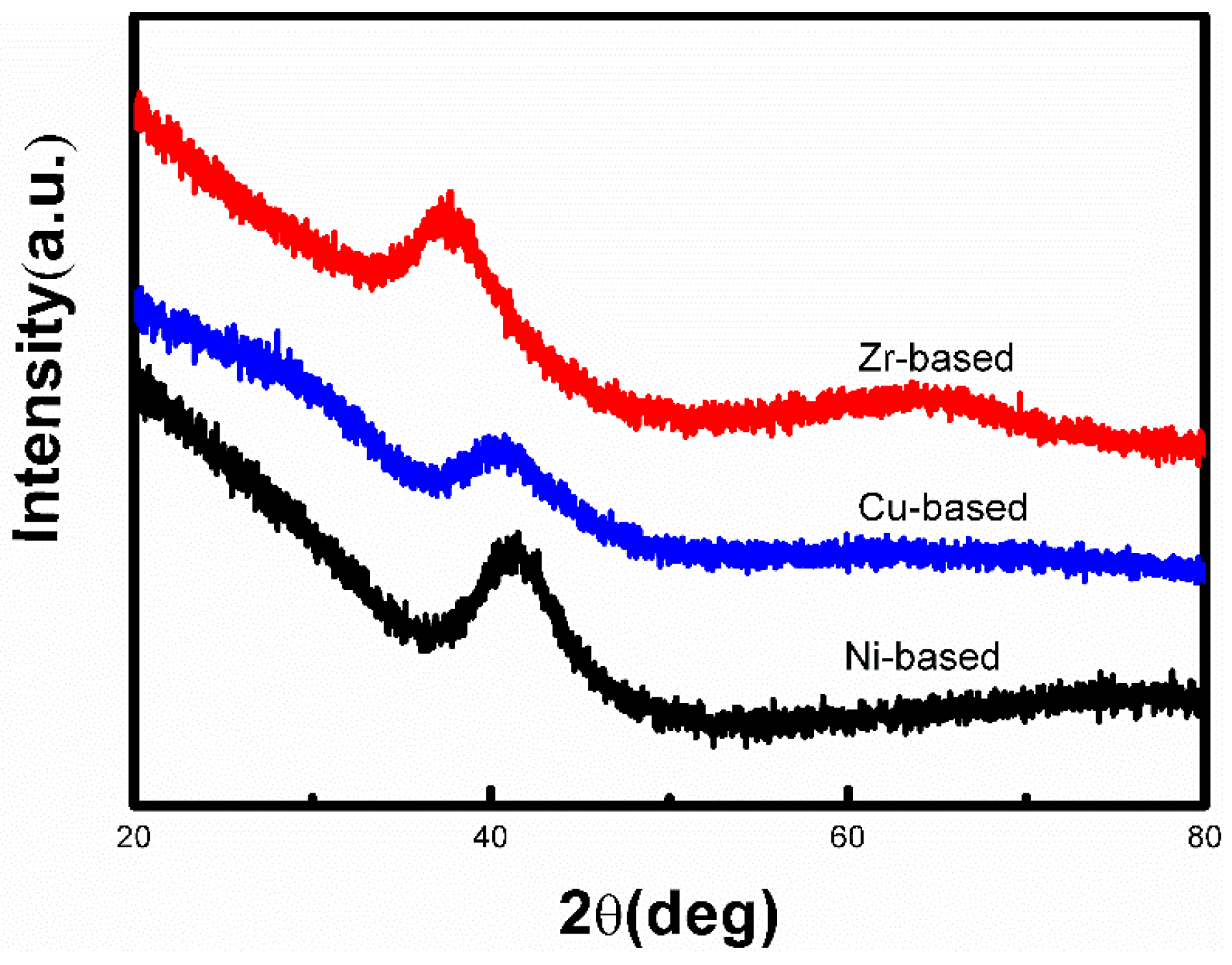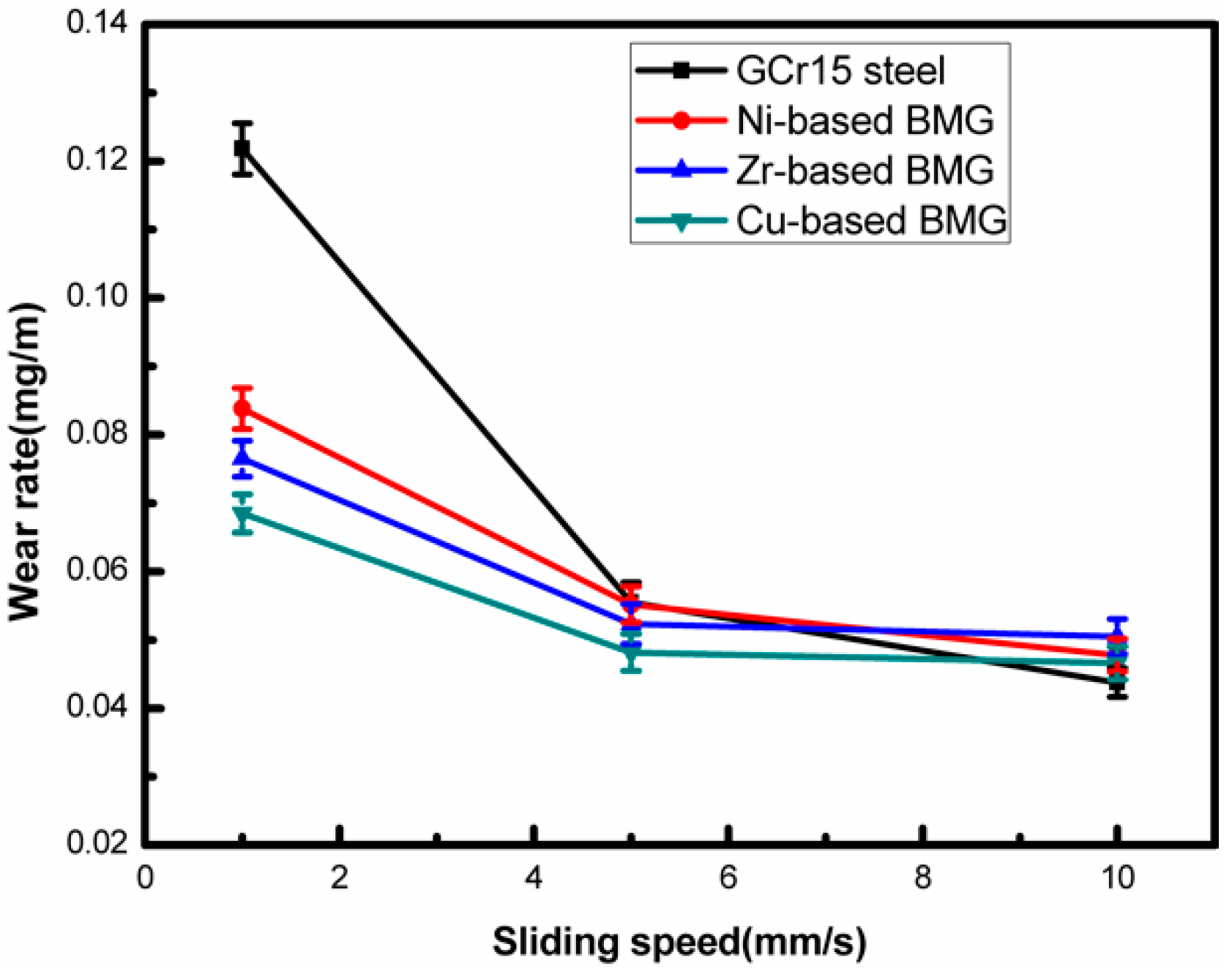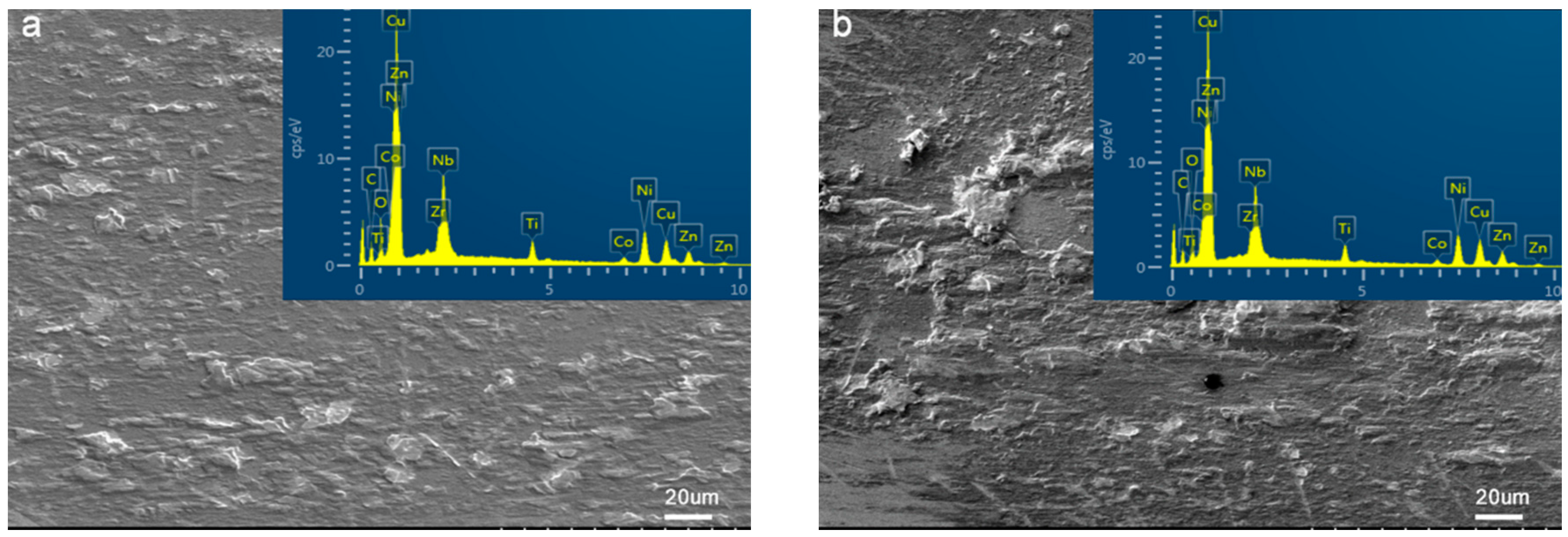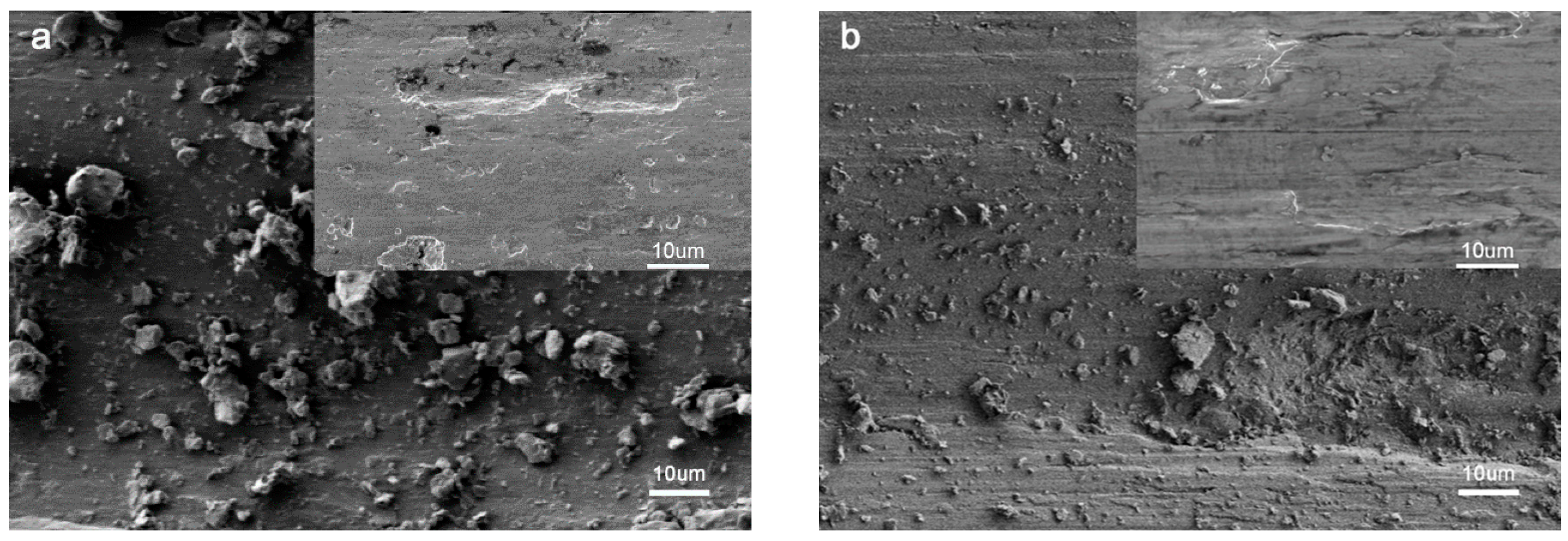Wear Behaviors of Three Typical Bulk Metallic Glasses in Bearing Applications
Abstract
:1. Introduction
2. Materials and Methods
3. Experimental Results and Discussion
3.1. Structural Characterization
3.2. Relationship between Wear Rate of Brass Plates and Normal Loads
3.3. Relationship between Wear Rate of Brass Plates and Sliding Speeds
3.4. Worn Surfaces of Brass Plates under Different Loads
3.5. Worn Surfaces of Pins under Different Loads
3.6. Worn Surfaces of Brass Plates under Different Sliding Speeds
4. Conclusions
Author Contributions
Funding
Conflicts of Interest
References
- Inoue, A. Bulk amorphous and nanocrystalline alloys with high functional properties. Mater. Sci. Eng. A 2001, 304, 1–10. [Google Scholar] [CrossRef]
- Kawashima, A.; Wada, T.; Ohmura, K.; Xie, G.; Inoue, A. A Ni- and Cu-free Zr-based bulk metallic glass with excellent resistance to stress corrosion cracking in simulated body fluids. Mater. Sci. Eng. A 2012, 542, 140–146. [Google Scholar] [CrossRef]
- Duan, H.T.; Tu, J.; Du, S.M.; Kou, H.C.; Li, Y.; Wang, J.P.; Chen, Z.W.; Li, J. Tribological properties of Ti40Zr25Ni8Cu9Be18 bulk metallic glasses under different conditions. Mater. Des. 2011, 32, 4573–4579. [Google Scholar] [CrossRef]
- Wang, L.; Chao, Y. Corrosion behavior of Fe41Co7Cr15Mo14C15B6Y2 bulk metallic glass in NaCl solution. Mater. Lett. 2012, 69, 76–78. [Google Scholar] [CrossRef]
- Inoue, T.Z.A. New bulk glassy Ni-based alloys with high strength of 3000 MPa. Mater. Trans. 2002, 43, 708–711. [Google Scholar]
- Heilmaier, M. Deformation. behavior of Zr-based metallic glasses. J. Mater. Process. Technol. 2001, 117, 374–380. [Google Scholar] [CrossRef]
- Yokoyama, Y.; Fukaura, K.; Sunada, H. Fatigue properties and microstructures of Zr55Cu30Al10Ni5 bulk glassy alloys. Mater. Trans. JIM 2000, 41, 675–680. [Google Scholar] [CrossRef]
- Inoue, A.; Zhang, W.; Zhang, T.; Kurosaka, K. Cu-based bulk glassy alloys with high tensile strength of over 2000 MPa. J. Non-Cryst. Solids 2002, 304, 200–209. [Google Scholar] [CrossRef]
- Inoue, A.; Wang, X.M.; Zhang, W. Developments and applications of bulk metallic glasses. Rev. Adv. Mater. Sci. 2008, 18, 1–9. [Google Scholar]
- Ishida, M.; Takeda, H.; Nishiyama, N.; Kita, K.; Shimizu, Y.; Saotome, Y.; Inoue, A. Wear resistivity of super-precision microgear made of Ni-based metallic glass. Mater. Sci. Eng. A 2007, 449, 149–154. [Google Scholar] [CrossRef]
- Ma, M.Z.; Liu, R.P.; Xiao, Y.; Lou, D.C.; Liu, L.; Wang, Q.; Wang, W.K. Wear resistance of Zr-based bulk metallic glass applied in bearing rollers. Mater. Sci. Eng. A 2004, 386, 326–330. [Google Scholar] [CrossRef]
- Liu, L.F.; Zhang, H.A.; Shi, C. Sliding tribological characteristics of a Zr-based bulk metallic glass near the glass transition temperature. Tribol. Lett. 2009, 33, 205–210. [Google Scholar] [CrossRef]
- Zhao, J.; Gao, M.; Ma, M.; Cao, X.; He, Y.; Wang, W.; Luo, J. Influence of annealing on the tribological properties of Zr-based bulk metallic glass. J. Non-Cryst. Solids 2018, 481, 94–97. [Google Scholar] [CrossRef]
- Wang, Y.; Zhang, L.; Wang, T.; Hui, X.D.; Chen, W.; Feng, C.F. Effect of sliding velocity on the transition of wear mechanism in (Zr,Cu)95Al5 bulk metallic glass. Tribol. Int. 2016, 101, 141–151. [Google Scholar] [CrossRef]
- Tao, P.; Yang, Y.; Xie, Z.; He, Y. Research on friction and wear behavior of a bulk metallic glass under different sliding velocity. Mater. Lett. 2015, 156, 177–179. [Google Scholar] [CrossRef]
- Rahaman, M.L.; Zhang, L.; Liu, M.; Liu, W. Surface roughness effect on the friction and wear of bulk metallic glasses. Wear 2015, 332, 1231–1237. [Google Scholar] [CrossRef]
- Rahaman, M.L.; Zhang, L. Size effect on friction and wear mechanisms of bulk metallic glass. Wear 2017, 376, 1522–1527. [Google Scholar] [CrossRef]
- Rahaman, M.L.; Zhang, L.C.; Ruan, H.H. Understanding the friction and wear mechanisms of bulk metallic glass under contact sliding. Wear 2013, 304, 43–48. [Google Scholar] [CrossRef]
- Prakash, B.; Hiratsuka, K. Sliding wear behaviour of some Fe-, Co- and Ni-based metallic glasses during rubbing against bearing steel. Tribol. Lett. 2000, 8, 153–160. [Google Scholar] [CrossRef]








© 2018 by the authors. Licensee MDPI, Basel, Switzerland. This article is an open access article distributed under the terms and conditions of the Creative Commons Attribution (CC BY) license (http://creativecommons.org/licenses/by/4.0/).
Share and Cite
Wang, D.-H.; Xie, S.-H.; Yang, H.-P.; Qian, H.-X.; Zeng, X.-R. Wear Behaviors of Three Typical Bulk Metallic Glasses in Bearing Applications. Metals 2018, 8, 1005. https://doi.org/10.3390/met8121005
Wang D-H, Xie S-H, Yang H-P, Qian H-X, Zeng X-R. Wear Behaviors of Three Typical Bulk Metallic Glasses in Bearing Applications. Metals. 2018; 8(12):1005. https://doi.org/10.3390/met8121005
Chicago/Turabian StyleWang, Dong-Hui, Sheng-Hui Xie, Hai-Peng Yang, Hai-Xia Qian, and Xie-Rong Zeng. 2018. "Wear Behaviors of Three Typical Bulk Metallic Glasses in Bearing Applications" Metals 8, no. 12: 1005. https://doi.org/10.3390/met8121005
APA StyleWang, D.-H., Xie, S.-H., Yang, H.-P., Qian, H.-X., & Zeng, X.-R. (2018). Wear Behaviors of Three Typical Bulk Metallic Glasses in Bearing Applications. Metals, 8(12), 1005. https://doi.org/10.3390/met8121005




